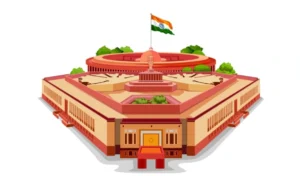The Constitution of India establishes a parliamentary system of government where the President is the nominal head of the State, the Prime Minister is the real executive authority, and the Parliament is the supreme legislative body.
Together, they ensure the smooth functioning of democracy. This framework is inspired by the British parliamentary model but adapted to Indian needs.
It provides for a clear division of powers and responsibilities, ensuring a balance between the executive, legislature, and the ceremonial head of state.
This system not only guarantees democratic accountability but also strengthens the principle of collective responsibility in governance.
President of India – Powers & Roles
| Aspect | Details |
|---|---|
| Position | Head of State, Supreme Commander of Armed Forces |
| Election | Elected by Electoral College (MPs + MLAs of States/UTs with legislatures) |
| Tenure | 5 years; eligible for re-election |
| Executive Powers | Appoints PM, Council of Ministers, Governors, Judges, CAG, etc. |
| Legislative Powers | Summons & prorogues Parliament, dissolves Lok Sabha, nominates members, gives assent to bills (can also withhold or return certain bills). |
| Judicial Powers | Grants pardons, reprieves, commutations under Article 72. |
| Emergency Powers | Can proclaim National, State, or Financial Emergency (Articles 352, 356, 360). |
| Special Role | Works on advice of the Council of Ministers headed by PM. |
Prime Minister of India – Powers & Roles
| Aspect | Details |
|---|---|
| Position | Real head of government; leader of Council of Ministers |
| Appointment | Appointed by the President (leader of majority party/alliance in Lok Sabha) |
| Executive Powers | Allocates portfolios to ministers, supervises functioning of ministries |
| Legislative Powers | Leader of the House; advises President to summon/dissolve Lok Sabha |
| Advisory Role | Advises President on key appointments (judges, governors, CAG, etc.) |
| Foreign Policy | Represents India internationally; plays leading role in treaties, diplomacy |
| Emergency Role | Key decision-maker during emergencies |
| Collective Leadership | Heads Cabinet meetings; his decisions guide national policies |
Parliament of India – Powers & Roles
Parliament is the supreme legislative authority of India. It consists of:
👉 President + Lok Sabha (Lower House) + Rajya Sabha (Upper House)
| Aspect | Details |
|---|---|
| Lok Sabha | 552 members max; directly elected; 5-year tenure (can be dissolved earlier). |
| Rajya Sabha | 250 members max; elected by state legislatures; permanent body (1/3rd members retire every 2 years). |
| Legislative Powers | Makes laws on Union & Concurrent List subjects. |
| Financial Powers | Controls Union Budget, taxation, public expenditure (Money Bills only in Lok Sabha). |
| Executive Control | Council of Ministers is collectively responsible to Lok Sabha. |
| Amendment Powers | Can amend Constitution under Article 368. |
| Judicial Powers | Can impeach President, remove Judges of SC/HC. |
| Electoral Role | Participates in elections of President & Vice-President. |
Key Facts for Exams
- President = Nominal Executive (de jure head), functions on advice of Council of Ministers.
- Prime Minister = Real Executive (de facto head), holds actual decision-making power.
- Parliament = Legislature, makes laws and holds executive accountable.
- Lok Sabha is more powerful in financial matters (Money Bills).
- Rajya Sabha = “Permanent House” (not dissolved, only 1/3rd retires every 2 years).
Comparison: President vs Prime Minister vs Parliament
| Feature | President of India | Prime Minister of India | Parliament of India |
|---|---|---|---|
| Position | Nominal / Constitutional Head of State | Real Executive Head (Council of Ministers leader) | Supreme Legislative Body |
| Appointment / Election | Elected by Electoral College (MPs + MLAs) | Appointed by President (usually leader of majority party in Lok Sabha) | Members elected by people (Lok Sabha) + States/UTs (Rajya Sabha) |
| Powers | Executive powers exercised in name of President, but on advice of PM & Council | Controls actual executive powers, policy-making, administration | Makes laws, controls finances, approves budgets, checks executive |
| Tenure | 5 years (can be re-elected) | 5 years or as long as he/she has majority support in Lok Sabha | 5 years (Lok Sabha), Rajya Sabha is permanent body with 1/3rd members retiring every 2 years |
| Role in Government | Ceremonial; ensures constitutional functioning | Head of Government; directs ministries, administration, foreign policy | Law-making, discussion of policies, accountability of executive |
| Special Powers | Can dissolve Lok Sabha, summon Parliament, promulgate ordinances, declare emergency | Advises President, leads cabinet, coordinates governance | Can amend Constitution, pass no-confidence motion, remove Govt. |
| Accountability | Not directly accountable to Parliament | Directly accountable to Lok Sabha | Accountable to the people (through elections) |
| Example | Approves bills into laws (assent) | Designs policies, leads governance (e.g., economic reforms) | Passes bills, debates issues, holds government accountable |
President = Head of the State (symbolic, constitutional)
Prime Minister = Head of the Government (real power)
Parliament = Head of the Legislature (law-making & oversight)

Leave a Comment Cancel reply